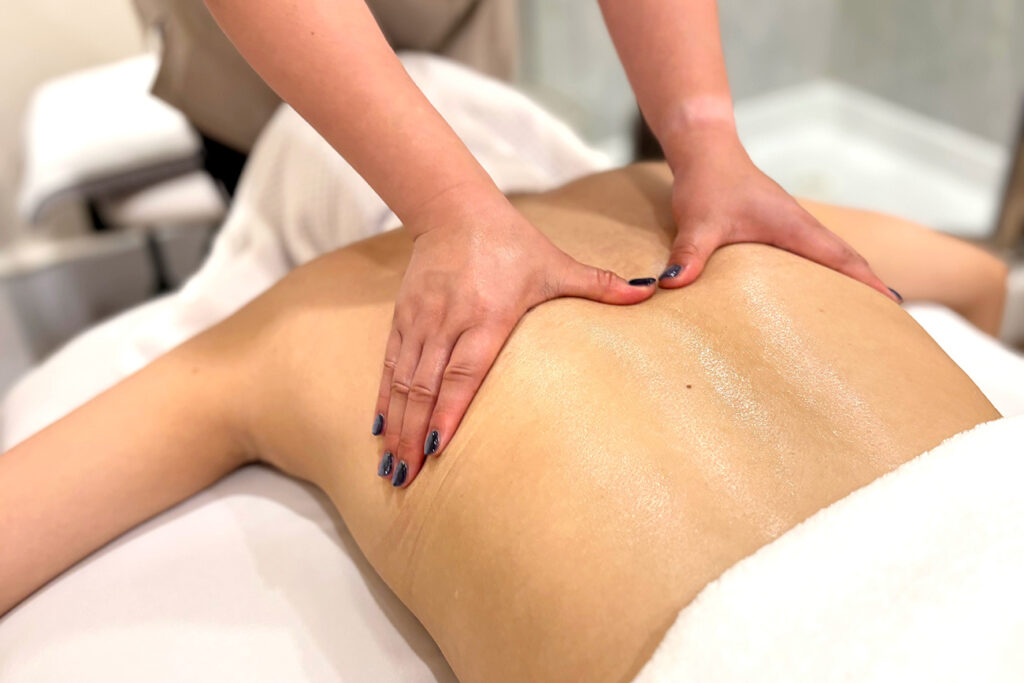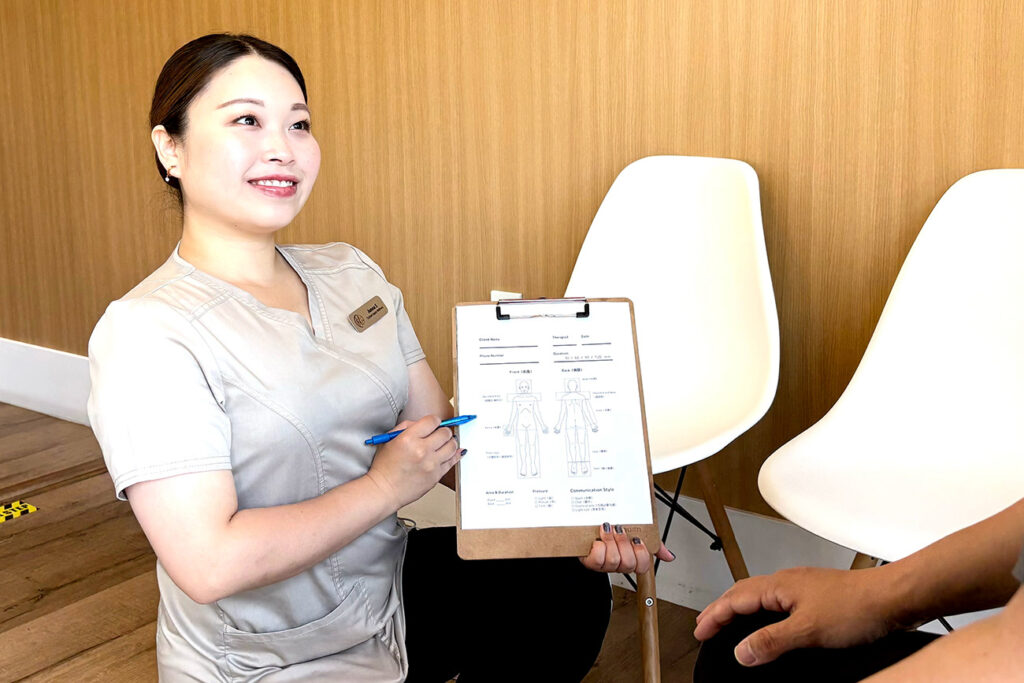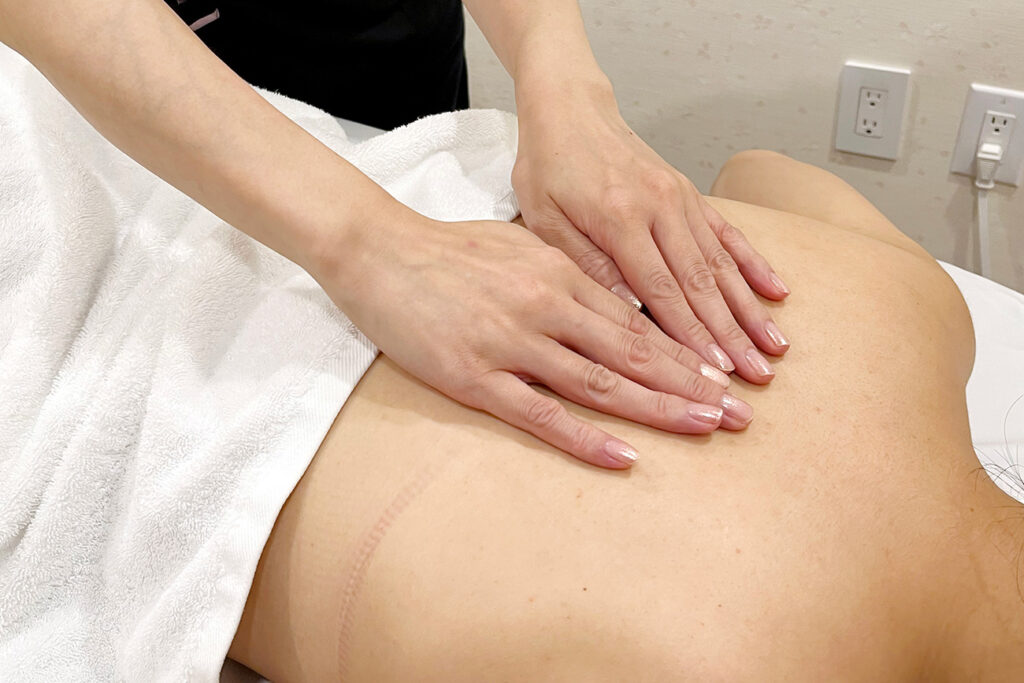Swedish massage is popular for its effectiveness in helping both body and mind relax and recover from fatigue.
This article explains the basics of Swedish massage and details the benefits you can expect.
What Is Swedish Massage? Understanding the Basics
Definition and Key Features of Swedish Massage
Swedish massage is considered the foundation of Western massage. By gently—at times firmly—kneading along the direction of muscle fibers and lymph flow, it eases bodily tension and enhances relaxation.
It commonly uses oil, creating a smooth, gliding touch.
Swedish massage is not merely for relaxation. Grounded in anatomy and physiology, its techniques work into deeper layers of tissue to produce a range of benefits. In addition to releasing muscle stiffness and tightness, it can boost circulation and lymphatic flow, promoting the removal of metabolic waste.
It is also effective for reducing mental stress. Receiving a massage shifts the body toward parasympathetic dominance, bringing both mind and body into a relaxed state. It can help ease anxiety, tension, and irritability, restoring a calm mood.
Swedish massage supports overall wellness and beauty—truly a versatile modality. With regular sessions, you can balance the body and strive for a healthier, more vibrant you.
How It Differs from Other Massages
Compared with other oil-based modalities like aromatherapy or lymphatic massage, Swedish massage focuses more directly on the muscles themselves. As a result, it can deliver deeper relaxation and more effective recovery from fatigue.
Aromatherapy enhances relaxation through the effects of essential oils. While lymphatic massage primarily aims to encourage lymph flow and waste removal, Swedish massage targets the muscles through kneading to ease tension and improve circulation.
Because it works directly on muscle tissue, Swedish massage is effective for chronic issues such as stiff shoulders and lower back discomfort. It also helps post-exercise muscle recovery and, by improving flexibility, can aid in injury prevention.

In short, Swedish massage takes a distinct approach that can address a wide range of concerns. Choosing the right massage for your goals and condition is key.
A Brief History of Swedish Massage
Swedish massage is said to have been systematized in the early 19th century by Sweden’s Pehr Henrik Ling. It spread across Europe and is now practiced and loved worldwide.
Pehr Henrik Ling was both a physician and a physical education teacher. Drawing on research in anatomy and physiology, he developed Swedish massage techniques that offered not just relaxation but therapeutic benefits as well.
It came to be widely used in European medical settings and eventually spread globally. Today, athletes and dancers—those who place heavy demands on their bodies—use it for recovery and injury prevention.
In Japan, Swedish massage has grown in popularity in recent years. Many aesthetic and relaxation salons now offer it, and its benefits are widely recognized.
Expected Benefits: Mind and Body
Easing Muscle Tension and Aiding Recovery
Massage loosens muscles and boosts circulation, helping flush out fatigue-related byproducts. It’s also effective for easing chronic issues like shoulder stiffness and lower back pain.
Muscle tension arises from prolonged static postures and stress. Tight muscles constrict blood vessels, hindering circulation. When circulation drops, oxygen and nutrients fail to reach the muscles adequately and fatigue substances build up—leading to problems such as stiff shoulders and low back pain.
By kneading the muscles, Swedish massage relieves tension and improves blood flow. Better circulation delivers oxygen and nutrients while carrying away waste, thereby easing symptoms.
It also enhances flexibility, allowing smoother movement and helping to prevent injuries.
Relaxation and Stress Relief
The gentle touch and aroma can relax body and mind, reducing stress, improving sleep quality, and promoting emotional stability.
Modern life is filled with stress—work, relationships, finances, and more. Chronic stress disrupts autonomic balance, causing insomnia, irritability, and anxiety.
Swedish massage helps shift the body toward parasympathetic dominance. Heart rate and breathing settle, muscles relax, and overall stress diminishes.
Aromas act directly on the brain to deepen relaxation. Choosing an essential oil you enjoy can further enhance the effect.
It can also encourage better sleep, helping you drift off in a relaxed state and wake refreshed.
Improved Circulation and Metabolism
Massage stimulates circulation and boosts metabolism. It may help improve cold sensitivity and reduce swelling.
Poor circulation contributes to cold extremities, edema, and skin problems. When blood flow is inadequate, cells receive less oxygen and nutrients while wastes accumulate; metabolism slows and skin turnover is delayed.
Swedish massage dilates blood vessels and encourages circulation, delivering oxygen and nutrients while promoting waste removal. It can also activate metabolism and support healthy skin turnover.
It’s effective for cold sensitivity: warmer, better-circulated extremities feel less chilled. By promoting lymph flow, it also helps drain excess fluid and waste to reduce swelling.
Types of Swedish Massage and Typical Flow
Common Session Types
Options include full-body oil sessions and focused area sessions that target the most fatigued regions. Oils and aromas vary by salon, so choose according to your preference.
A full-body course kneads all major muscle groups, promoting circulation throughout and enhancing recovery. It can address issues such as stiff shoulders, lower back discomfort, and swelling, while providing high levels of relaxation and stress relief.
Focused sessions work intensively on areas like shoulders, neck, lower back, or legs. They’re ideal when you want noticeable results in a shorter time—perfect for busy schedules or specific concerns.
Some salons let you choose the essential oil or adjust pressure. Select the course that best fits your preferences and condition.
Typical Session Flow
Counseling → Changing → Massage → After-tea is the standard flow. During the massage, communicate with your therapist so they can adjust pressure as needed.
In the counseling, you’ll discuss your condition, concerns, and any allergies. If you have questions or worries, don’t hesitate to ask. You’ll also receive an explanation of the session and the oils used.

For changing, you’ll put on a salon-provided gown or disposable shorts for comfort during the session. Remove accessories and watches. If you wear contact lenses, you may relax more by taking them out.
While receiving the massage, communicate with your therapist to adjust pressure or technique. If anything feels painful, say so—then relax and enjoy the time.
After-tea helps with hydration and waste removal following the session. Depending on the salon, you may be offered herbal tea or warm water. You can also discuss how you feel afterward with your therapist.
Precautions When Receiving a Massage
If you’re feeling unwell or are pregnant, consult the salon in advance. After the session, be sure to hydrate and take time to rest.
Receiving a massage when you’re not feeling well can worsen symptoms. Avoid sessions if you have a fever or cold-like symptoms. Likewise, do not receive massage over inflamed skin or open wounds.
If you are pregnant, always consult your physician first. Because hormonal changes can make your condition more delicate, choose treatments that are safe during pregnancy.
Post-session, drink plenty of fluids and rest. Massage boosts circulation and waste removal, so hydration supports that process. Rest also helps muscles recover from fatigue.

